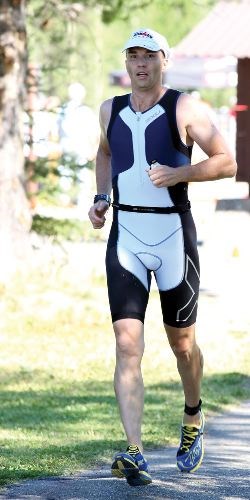Back in 1986, not long after Frank Blues came to Prince George from Dundee, Scotland to take a job with the city, he decided to race in the Prince George Triathlon.
At the time, the race started with a swim at Nukko Lake, followed by a bike ride to Otway Nordic Centre and a run that started and ended at Otway, one of several evolutions in the city's triathlon history.
"That year we had a half-Ironman as part of the event," said Blues. That was back in the days of Bill Kerr (a Canadian masters triathlon champion) who was ranked in Canada, and he was supported by guys like Bob Kapphahn.
"It later moved from Nukko Lake to the Nechako River and Cottonwood Island Park was the transition area. The swim was in the Nechako River for a few years and we biked up Highway 16 East on an out-and-back course, then we did our run on the river trails."
Blues remembers the river being quite shallow in places and the challenge was finding a route where the water remained deep enough to swim the entire way. Swimmers would hit shallow spots and then have to run to get to swimmable water.
Tom Kurhinen used to sponsor the Prince George race in the late-'80s and early-'90s as part-owner of Ultrasport, a downtown sporting goods store. He also entered it, racing every year until 2009. Kurhinen liked having the race at Cottonwood Island Park, but that lasted only a couple of years before it was moved to West Lake.
"It was a great site because back then you were able to use the highways," Kurhinen said. "Back then we did the swim right at Cottonwood Park. They tried to make it a loop swim and the water wasn't very fast at the time so you swam around a couple little islands and come back around. You didn't need a wet suit because it was really warm water."
After the scene switched to West Lake, Kurhinen and his training partners Stephen Wing and Darren Masse used the P.G. Triathlon as a training race for the Penticton Ironman.
"We had a bit of series with Prince George, Smithers and Quesnel, all within a couple weeks of each other," he said.
It wasn't unusual for the three of them, the day before the race, to swim two km in the lake, ride 90 km to Baldy Hughes, then go for a 15 km run. One year they drove up to Mackenzie and did the sprint triathlon the day before the Olympic distance race at West Lake.
"That's why I'm a broken-down old man now," chuckled Kurhinen.
Originally known as the Fitness First Triathlon, the inaugural Prince George race happened on Aug. 28, 1983 and instead of swimming it involved paddling.
It started and finished at Parkhill Plaza (off Highway 97 near the current Theatre Northwest site). The first leg was 30 km bike ride up the Hart Highway to Chief Lake Road, down Foothills Boulevard to the John Hart bridge, canoeists followed a six km route on the Nechako River to Fort George Park. The 10 km running route started at the park and went along Patricia Boulevard to First Avenue, then over Cameron Street bridge east on Prince George Pulp Mill Road and back again to the Parkhill Centre.
Now 61, retired a full year from his city management job, Blues stays active with running, biking, swimming, skiing and yoga. But he's not racing in this year's Brink Group of Companies/Northern Sport Centre Prince George Triathlon on Sunday, July 17 at West Lake. He's got enough on his hands as race director, having taken over the volunteer post from Craig Somerville.
Blues considers the current site at West Lake's north shore beach, 22 kilometres south of Prince George off Blackwater Road, perfect for race organizers and spectators. Because it's removed from the city traffic there aren't many moving hazards from racers to deal with and it's much easier to control motorized traffic access to the race route.
"You've got great parking, all the action is right there for spectators, and as competitor you can take your equipment to one place, set up and pick it up at the end," said Blues. "We've got on-site toilets (and showers), on-site fresh water, and a shelter in the event of inclement weather."
Racers have their choice of Olympic distance triathlon (1.5 km swim, 40 km bike, 10 km run), sprint triathlon (750 metre swim, 20 km bike, five km run) or the duathlon (two five km runs at either end of a 40 km ride).
"The course is challenging," said Blues. "It's hilly and rolling for the bike, and slightly rolling for the run. There's about 300 metres of elevation on the 20 km bike ride and about 450 metres of elevation on the standard triathlon and duathlon, so you're climbing about 1,000 feet. It's one of the more challenging triathlons. You just have to be prepared for the hills."
Blues says the triathlon is a great team event and like the popular Iceman multisport endurance race in February, it gives people a reason to train throughout the year. He's encouraging families and local businesses to put teams together for the July race. Race organizers are in the process of setting up a component of the triathlon website which will link individuals to other racers looking to form teams.
"It's so much easier with limited training to participate on a team," said Blues. "This is a summer equivalent to the Iceman people just looking to stay in shape and enjoy what Prince George and its surroundings have to offer."
More people are needed to help run the race. Interested volunteers can contact Blues at 250-552-4996 or email [email protected]. To register for the race, go to strideandglide.ca. More race information is available at unbc.ca/northern-sport-centre/pg-triathlon.



